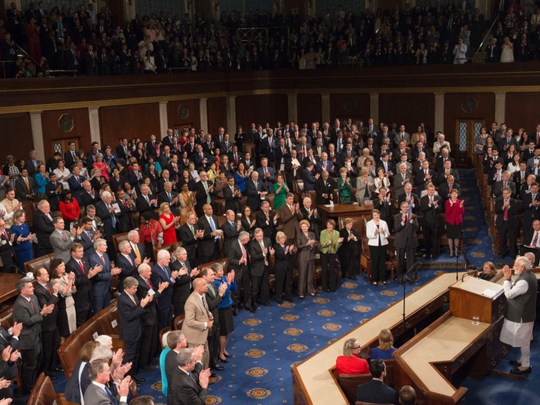
The seeds of bonhomie that were sown on the lawns of Hyderabad House on a chilly January afternoon last year, seemed to have reached fruition within the august precincts of Capitol Hill last Wednesday.
On January 25, 2015, during American President Barack Obama’s second state visit to India, Prime Minister Narendra Modi cut through protocol and served tea to his guest from the White House during a tete-a-tete between the leaders of the world’s oldest and largest democracies. As the Obama-Modi informal one-on-one on the greens made headlines the world over, it was evident that both Washington and New Delhi were determined to take their bilateral relationship several notches higher than what the fine print of the civil nuclear deal would imply and propagate in terms of its strict adherence to nuanced diplomacy.
On June 8, 2016, as Modi regaled a joint session of the US Congress on what was his fourth visit to America since winning the 2014 general elections, Obama was not present at the venue, but the spirit of the Obama-Modi junk-the-rulebook camaraderie was all-pervasive. The numerous rounds of applause, those spontaneous standing ovations by US lawmakers, Modi’s trademark elan in transforming the sombre-sobriety of a high-brow lecture into a breaking-the-ice banter laced with light humour and most of all — a speech packed with a high-octane message to hard-sell India as a partner with several points of convergence with America in terms of mutual global and geopolitical interests, marked a clear and bold departure from the hackneyed ‘you first’ brand of Indian outreach to Uncle Sam for decades.
So, in terms of realpolitik and gamesmanship, New Delhi indeed has walked a long way from a Manmohan Singh chiming “President Bush, people of India love you”, to a Narendra Modi who categorically proclaims that “there’s a new symphony in play”!
To be fair to history, the thaw in US-India ties really began with former prime minister Rajiv Gandhi’s visit to Washington in 1985. As the youngest-ever premier of the world’s largest democracy, Rajiv’s “I am young, I have a dream” struck an immediate chord with the members of the US Congress. Interestingly, the then US president, Ronald Reagan, though a contemporary of Rajiv’s mother and former PM Indira Gandhi, reportedly hit it off bigtime with the son. Rajiv’s sincere pitch for a robust Indo-US friendship and stronger bilateral ties had impressed Reagan and the US administration a lot.
Moreover, Rajiv’s push for modernisation in telecom and information technology generated enough interest among the Washington mandarins. A decade later, in 1994, when P.V. Narasimha Rao addressed yet another joint session of the US Congress, his words found enough traction with Washington thinktanks and the White House, basking as he was under his new-found global legitimacy as the prime minister who had liberalised Indian economy and given India Inc its first true taste of adulthood.
Shaking off a pariah status
Then followed Atal Bihari Vajpayee’s erudite speech on Capitol Hill in 2000 that created quite a buzz in America, particularly his presentation of India as a “natural ally” of the US. Finally, when Manmohan Singh came to address a joint session of the US Congress in 2008, the Indo-US civil nuclear deal saw New Delhi shake off its pariah status in global civil nuclear trade and take definitive steps towards scripting a new chapter in bilateral relations marked by greater confidence and mutual trust.
From India’s first prime minister Jawaharlal Nehru’s address to a joint session of the US Congress in 1949, to India signing the civil nuclear deal in 2008, the contours of Indo-US ties have thrown up numerous challenges and pitfalls. The reported ill-treatment of Indian diplomat Devyani Khobragade in New York last year being a clear case in point as to how relations between the two vibrant democracies have often been soured by not-so-discreet powwows and their resultant domino effects. In that sense, Modi’s address to the US Congress and his latest visit to Washington mark a watershed in terms of presenting a nation of 1.25 billion people as an equal stake-holder with the world’s largest economic and military power in terms of shared concerns for global security, climate control and trade. Washington’s unequivocal support for New Delhi’s push for a permanent membership of the United Nations Security Council and at the 45-nation elite Nuclear Suppliers’ Group have helped bolster Indo-US ties like never before, marking a clear break from the days of India’s Nehruvian obsession with a socialist ideology and the subsequent pledge to nonalignment.
In that sense, the biggest significance of the Modi brand of foreign policy is its ability to secure America’s trust and confidence not just as a key South Asian nation with business and political sweet-spots for Washington, but as a respected stake-holder in America’s big-power game in the Asia-Pacific, particularly in the light of China’s ambitious and increasingly aggressive posturing in the South China Sea.
As India secured its membership of the crucial Missile Technology Control Regime during Modi’s US trip, albeit with Washington’s backing, the message has been delivered loud and clear to Beijing that keeping New Delhi locked out of NSG will only lead to isolation of China in the elite club. With Modi having secured Switzerland’s support during a pit-stop at Geneva, en route to Washington, followed by an affirmative nod from Mexico during Modi’s short visit to the country after winding up his US trip on Thursday, India’s parleys at consensus-building within the NSG are gathering steam.
From being persona non-grata, who had been denied a visa by the US for his alleged role in the 2002 Gujarat riots, to being a front-page headline grabber in the midst of a fever-pitch American presidential election season, the Indian prime minister has successfully dominated a discourse that doesn’t necessarily do a superpower’s bidding. To what extent this translates into benefits in real terms for India and how soon is what Modi will have to work on.
You can follow Sanjib Kumar Das on Twitter at www.twitter.com/@moumiayush








